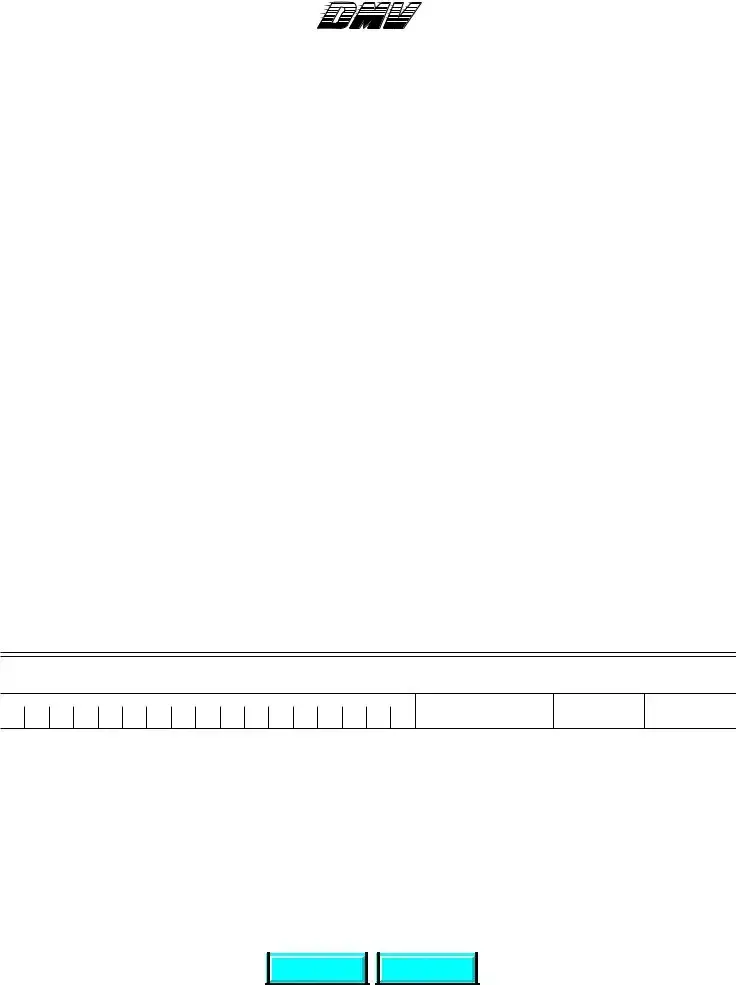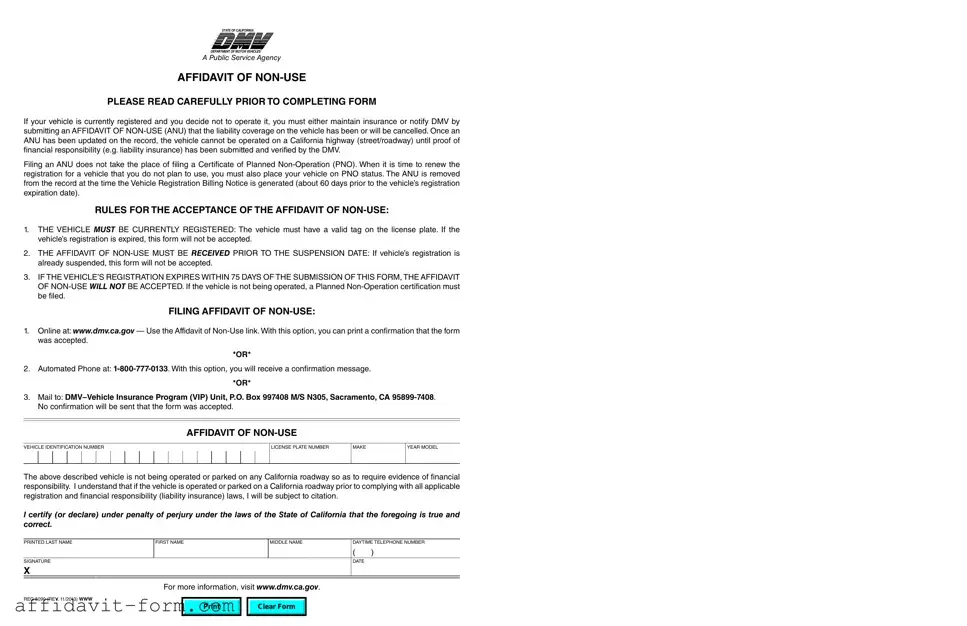
STATE OF CALIFORNIA
DEPARTMENT OF MOTOR VEHICLES®
A Public Service Agency
AFFIDAVIT OF NON-USE
PLEASE READ CAREFULLY PRIOR TO COMPLETING FORM
If your vehicle is currently registered and you decide not to operate it, you must either maintain insurance or notify DMV by submitting an AFFIDAVIT OF NON-USE (ANU) that the liability coverage on the vehicle has been or will be cancelled. Once an ANU has been updated on the record, the vehicle cannot be operated on a California highway (street/roadway) until proof of financial responsibility (e.g. liability insurance) has been submitted and verified by the DMV.
Filing an ANU does not take the place of filing a Certificate of Planned Non-Operation (PNO). When it is time to renew the registration for a vehicle that you do not plan to use, you must also place your vehicle on PNO status. The ANU is removed from the record at the time the Vehicle Registration Billing Notice is generated (about 60 days prior to the vehicle’s registration expiration date).
RULES FOR THE ACCEPTANCE OF THE AFFIDAVIT OF NON-USE:
1.THE VEHICLE MUST BE CURRENTLY REGISTERED: The vehicle must have a valid tag on the license plate. If the vehicle’s registration is expired, this form will not be accepted.
2.THE AFFIDAVIT OF NON-USE MUST BE RECEIVED PRIOR TO THE SUSPENSION DATE: If vehicle’s registration is already suspended, this form will not be accepted.
3.IF THE VEHICLE’S REGISTRATION EXPIRES WITHIN 75 DAYS OF THE SUBMISSION OF THIS FORM, THE AFFIDAVIT
OF NON-USE WILL NOT BE ACCEPTED. If the vehicle is not being operated, a Planned Non-Operation certification must be filed.
FILING AFFIDAVIT OF NON-USE:
1.Online at: www.dmv.ca.gov — Use the Affidavit of Non-Use link. With this option, you can print a confirmation that the form was accepted.
*OR*
2.Automated Phone at: 1-800-777-0133. With this option, you will receive a confirmation message.
*OR*
3.Mail to: DMV–Vehicle Insurance Program (VIP) Unit, P.O. Box 997408 M/S N305, Sacramento, CA 95899-7408. No confirmation will be sent that the form was accepted.
AFFIDAVIT OF NON-USE
VEHICLE IDENTIFICATION NUMBER
The above described vehicle is not being operated or parked on any California roadway so as to require evidence of financial responsibility. I understand that if the vehicle is operated or parked on a California roadway prior to complying with all applicable registration and financial responsibility (liability insurance) laws, I will be subject to citation.
I certify (or declare) under penalty of perjury under the laws of the State of California that the foregoing is true and correct.
PRINTED LAST NAME |
FIRST NAME |
MIDDLE NAME |
DAYTIME TELEPHONE NUMBER |
|
|
|
|
|
|
|
( |
) |
|
|
|
|
|
|
|
|
|
SIGNATURE |
|
|
|
|
|
|
DATE |
|
X |
|
|
|
|
|
|
|
|
|
|
|
|
|
|
|
|
|
For more information, visit www.dmv.ca.gov. |
|
|
REG 5090 (REV. 11/2013) WWW |
|
|
|
|
|
|
|
|
|
|
|
|
|
|
|
|

